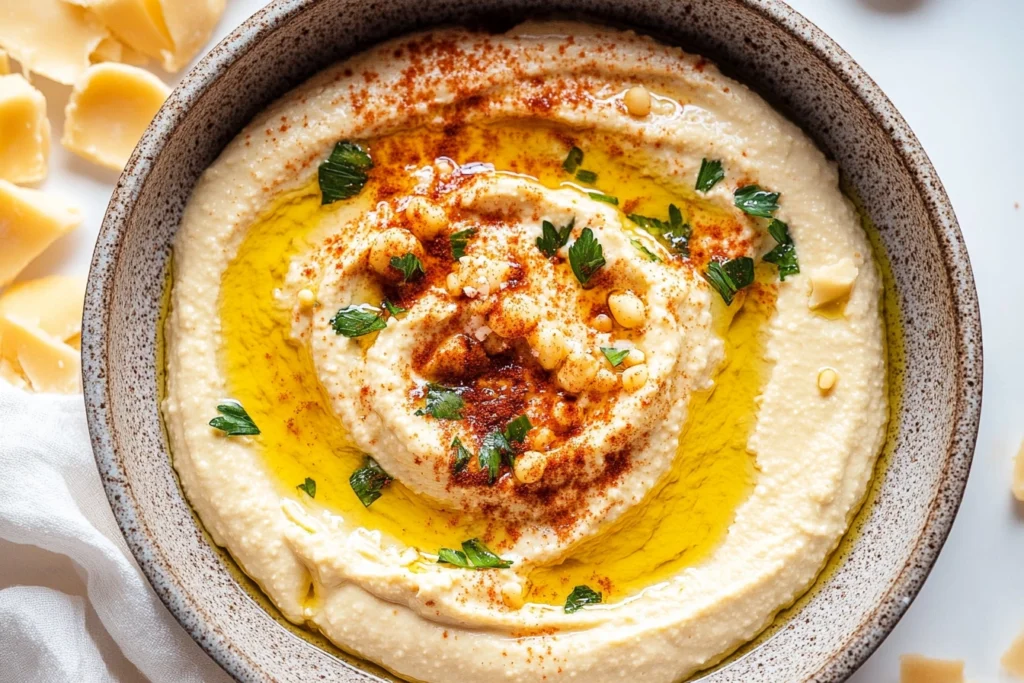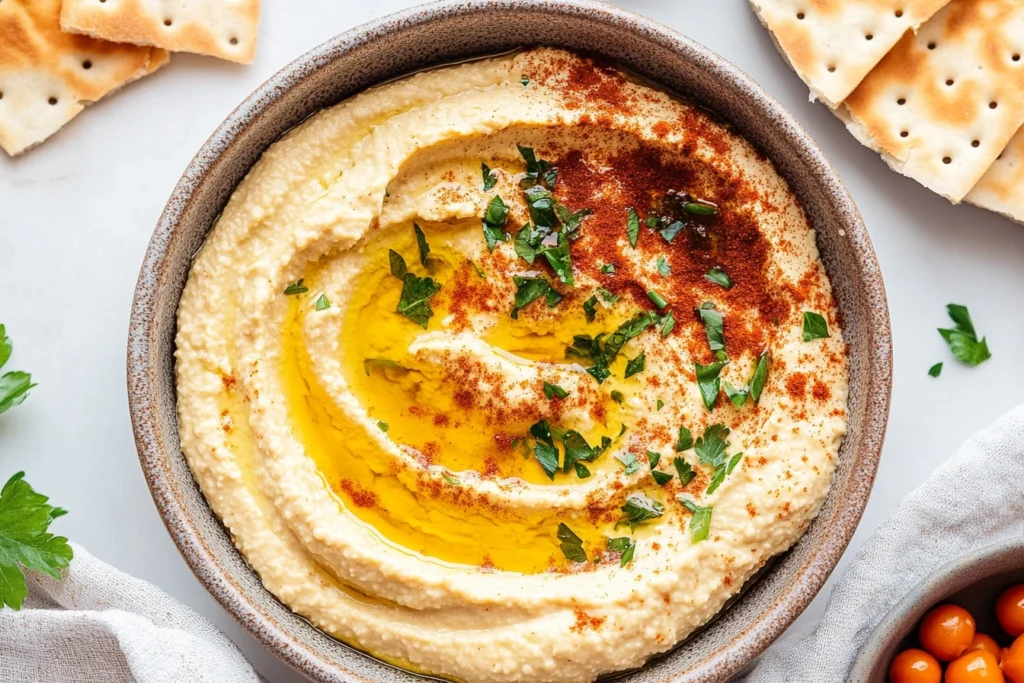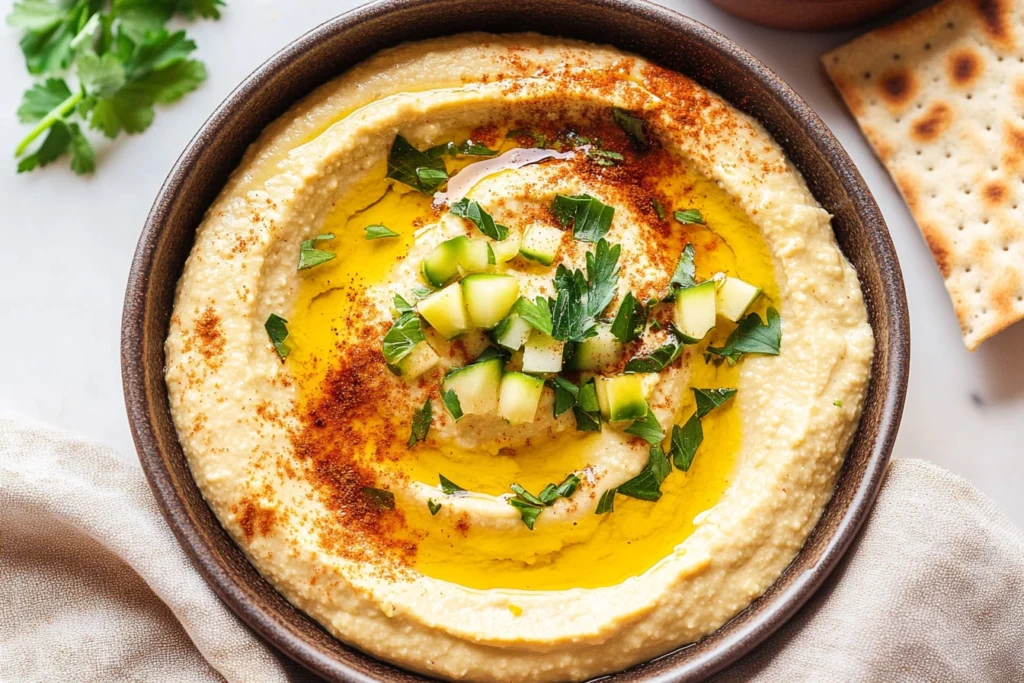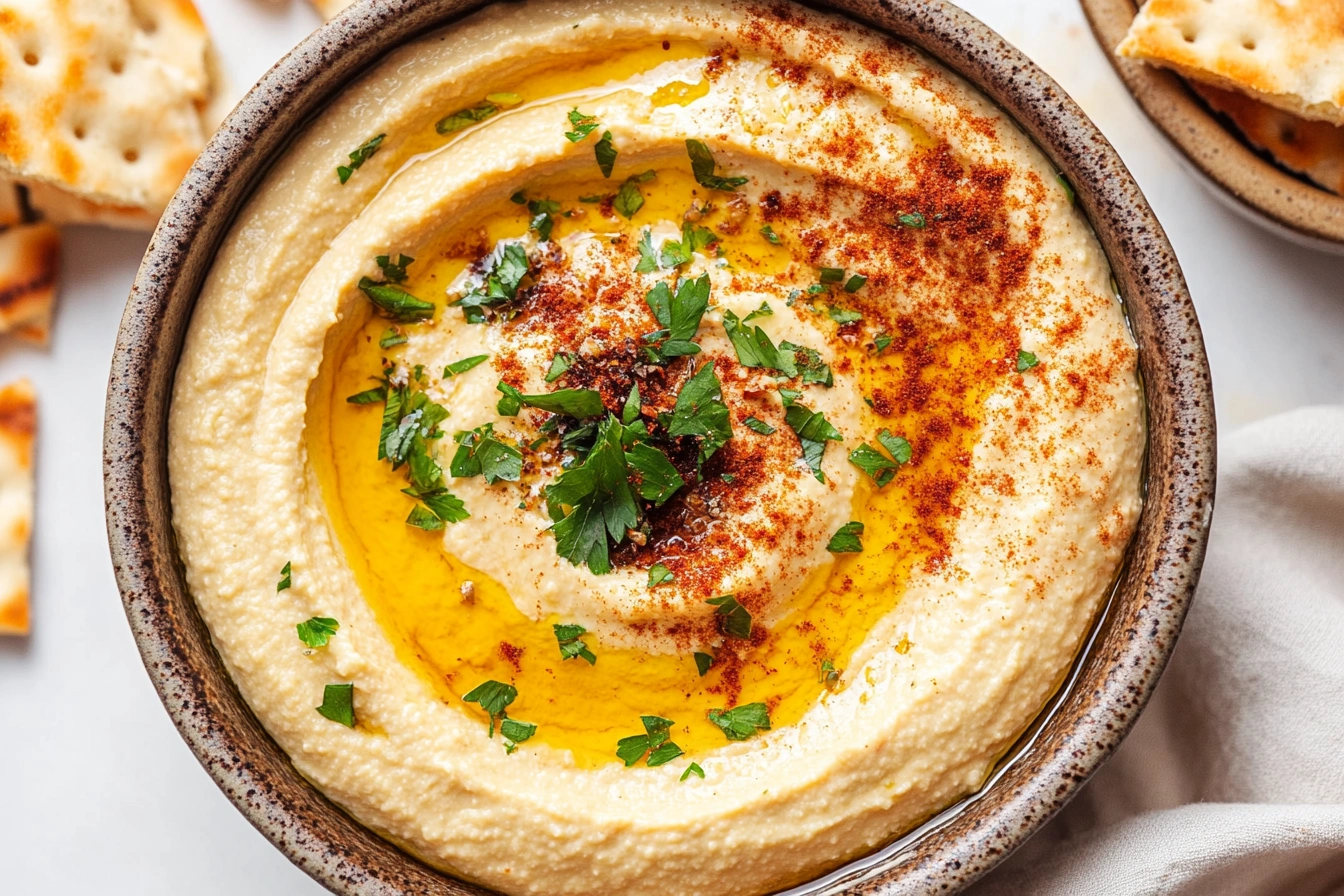Creamy hummus is more than just a simple dip, it’s a symbol of Mediterranean culture, healthful eating, and delightful flavor. Whether you enjoy it as a spread, a snack, or part of a hearty meal, getting that velvety smooth texture is key. This guide will walk you through the essential ingredients, simple steps, and even pro tips to achieve the perfect hummus every time. Let’s dive into the rich, flavorful world of this chickpea-based classic, step by step.
Introduction to Creamy Hummus
What Is Hummus?
Hummus is a creamy, protein-packed spread or dip made primarily from chickpeas, tahini (a sesame seed paste), lemon juice, garlic, and olive oil. Originating in the Middle East, it has become a globally loved dish because of its versatility and satisfying flavor.
Why Is Creamy Hummus a Popular Choice?
A bowl of smooth hummus is not just delicious; it’s nutritious and adaptable too. It pairs well with everything from crunchy veggies to warm pita bread, making it a crowd-pleaser at any table. Many also appreciate its role as a vegan and gluten-free option, ticking all the right boxes for a variety of diets.

Ingredients for Creamy Hummus
Traditional Ingredients
To make authentic creamy hummus, you’ll need just a handful of ingredients. Each one plays a crucial role in creating the dish’s signature flavor and texture:
- Chickpeas: The star ingredient! You can use dried chickpeas (soaked and cooked) or canned ones for convenience.
- Tahini: A rich sesame seed paste that adds a nutty depth. Always opt for high-quality tahini to avoid bitterness.
- Lemon Juice: Freshly squeezed lemon juice is non-negotiable for that bright, tangy kick.
- Garlic: A clove or two lends a pungent flavor. Roasted garlic is a gentler alternative if raw garlic feels too sharp.
- Olive Oil: Extra virgin olive oil is best, as it enhances the flavor and adds a silky finish.
- Salt: A pinch to balance the flavors.
Optional Add-Ins for Flavor Variations
While the traditional recipe is beloved for its simplicity, adding a twist can bring new excitement to the table. Consider these options:
- Paprika or Cayenne Pepper: Sprinkle on top for a smoky or spicy touch.
- Roasted Red Peppers: Blend them in for a sweeter, earthier hummus.
- Herbs: Fresh parsley or cilantro adds a refreshing element.
- Cumin: A dash of this earthy spice complements the chickpeas beautifully.
Quality Matters: Choosing the Right Chickpeas and Tahini
When it comes to hummus, the quality of your ingredients can make or break the dish. Opt for dried chickpeas if you’re aiming for maximum freshness and control over texture. Similarly, seek out tahini that’s smooth and well-balanced; some brands can be overly thick or bitter. Investing in good ingredients ensures that every bite bursts with flavor.
Step-by-Step Guide: How to Make Creamy Hummus
Preparing Chickpeas: Soaking, Cooking, or Using Canned
For the smoothest hummus, starting with perfectly prepared chickpeas is crucial.
- If using dried chickpeas: Soak them overnight in plenty of water with a pinch of baking soda to soften the skins. The next day, rinse and boil until tender. Cooking with a bit of baking soda can further break down the skins, making the texture even creamier.
- If using canned chickpeas: Drain and rinse thoroughly to remove the briny taste. For extra smoothness, remove the skins by gently rubbing the chickpeas in a clean kitchen towel.
Achieving the Perfect Texture: The Role of Ice Water
A surprising secret to creamy hummus is incorporating ice-cold water into the blending process. It emulsifies the tahini and chickpeas, resulting in a light and airy texture. Add the water gradually while blending until you reach the desired consistency.
Blending Process: Layering Ingredients for Maximum Creaminess
To get a velvety texture, the order in which you blend ingredients matters:
- Start by blending the tahini and lemon juice together until thick and creamy. This step ensures the tahini emulsifies fully before adding the chickpeas.
- Add the garlic and a pinch of salt, blending to combine.
- Gradually add the cooked or canned chickpeas while drizzling in olive oil and ice water. Continue blending until smooth.
Adjusting Flavors: Balancing Lemon, Garlic, and Salt
Taste as you go—this is your chance to customize the flavor. If it’s too tangy, balance it with a bit more olive oil or chickpeas. Too bland? Add another clove of garlic or a dash of salt. A perfectly balanced hummus will have a bright lemony tang, a nutty richness, and just the right amount of saltiness.
Serving and Pairing Creamy Hummus
Traditional Serving Styles
Hummus shines best when served simply yet elegantly. Spread it onto a shallow plate or bowl, creating a small well in the center. Drizzle generously with extra virgin olive oil, then sprinkle a touch of paprika, za’atar, or chopped parsley for a pop of color.
Creative Pairing Ideas
While hummus is traditionally paired with pita bread, the possibilities for serving are endless:
- Vegetables: Crunchy options like carrots, celery, cucumbers, and bell peppers are great for dipping.
- Crackers or Flatbreads: Whole-grain crackers, lavash, or even naan add a delicious crunch.
- Salads: Use hummus as a dressing by thinning it with a bit of lemon juice and water.
- Proteins: Serve alongside grilled chicken, falafel, or roasted chickpeas for a complete meal.
- Wraps and Sandwiches: Spread it on a tortilla or sandwich bread for a flavorful base.
Incorporating Hummus into Meals
Hummus isn’t just a side dish—it can be the star of your meal:
- Buddha Bowls: Use hummus as a creamy base or topping for grain bowls.
- Hummus Pasta: Stir it into cooked pasta for a silky, protein-packed sauce.
- Pizza Base: Swap traditional pizza sauce for hummus and top with roasted veggies.
Garnishing Tips for a Gourmet Look
A thoughtfully garnished bowl of creamy hummus is a feast for both the eyes and the palate. Try these finishing touches:
- Fresh Herbs: Sprinkle parsley, cilantro, or dill for a burst of freshness.
- Nuts and Seeds: Toasted pine nuts or sesame seeds add crunch and a nutty aroma.
- Infused Oils: Drizzle with chili oil or herb-infused olive oil for added flavor complexity.
- Spices: Dust the top with sumac, cumin, or smoked paprika for added depth.
Best Serving Platters and Tools
How you serve your hummus can elevate the experience:
- Shallow Bowls: Ideal for spreading and garnishing.
- Wooden Boards: Create a rustic vibe by placing hummus alongside its pairings.
- Mini Dishes: Perfect for individual servings at parties or events.

Health Benefits of Creamy Hummus
Nutritional Value of Hummus Ingredients
Hummus isn’t just delicious; it’s packed with nutrients that can contribute to a balanced diet:
- Chickpeas: High in fiber and plant-based protein, chickpeas support digestion and help maintain energy levels.
- Tahini: Rich in healthy fats and antioxidants, tahini also provides essential minerals like calcium and magnesium.
- Olive Oil: Known for its heart-healthy monounsaturated fats, olive oil is a staple of the Mediterranean diet.
- Garlic: A natural immune booster with anti-inflammatory properties, garlic adds more than just flavor.
- Lemon Juice: Loaded with vitamin C, lemon juice brings both flavor and a burst of antioxidants.
How Hummus Fits into Different Diets
One of the reasons for hummus’s popularity is its versatility in various dietary plans:
- Vegan and Vegetarian Diets: A plant-based protein source, hummus is ideal for those avoiding animal products.
- Gluten-Free Diets: Naturally free from gluten, it’s a safe and satisfying choice for those with celiac disease or gluten sensitivity.
- Keto Diet: While hummus contains some carbs, small portions can fit into a low-carb lifestyle if paired with keto-friendly veggies.
- Mediterranean Diet: Hummus embodies the principles of the Mediterranean diet, emphasizing healthy fats and whole foods.
Health Benefits Supported by Science
Regular consumption of creamy hummus can bring long-term health benefits:
- Supports Heart Health: The combination of olive oil and tahini is known to promote cardiovascular health.
- Boosts Digestive Wellness: Chickpeas are high in fiber, which supports gut health and regularity.
- Promotes Weight Management: Its high protein and fiber content can help you feel fuller longer, reducing overeating.
- Provides Essential Micronutrients: With ingredients rich in vitamins and minerals, hummus is a nutrient-dense snack option.
Why Homemade Hummus Is a Healthier Option
Store-bought hummus often contains preservatives, added oils, or high sodium levels. By making your hummus at home, you have full control over the ingredients, ensuring a healthier, cleaner version of this beloved dish.
Storage and Shelf Life of Creamy Hummus
Best Practices for Storing Homemade Hummus
To keep your homemade hummus fresh and flavorful, proper storage is essential:
- Airtight Containers: Use a sealed container to prevent air exposure, which can cause the hummus to dry out or spoil.
- Refrigeration: Always store hummus in the refrigerator at a temperature below 40°F (4°C) to maintain freshness.
- Cover with Olive Oil: Adding a thin layer of olive oil on top can act as a natural preservative, preventing the surface from drying out.
How Long Does Hummus Last in the Fridge?
Freshly made hummus typically lasts 4-7 days in the refrigerator when stored properly. If you notice changes in smell, taste, or texture, it’s best to discard it to avoid any risk of spoilage.
Can You Freeze Hummus? Tips for Long-Term Storage
Yes, hummus can be frozen to extend its shelf life! Follow these tips for the best results:
- Portion Before Freezing: Divide the hummus into smaller portions to thaw only what you need.
- Use Freezer-Safe Containers: Opt for airtight containers or freezer bags to protect the hummus from freezer burn.
- Leave Room for Expansion: Hummus expands slightly when frozen, so avoid overfilling containers.
- Thawing Instructions: To thaw, transfer the hummus to the refrigerator overnight. Stir it well before serving, as the texture may change slightly.
Signs Your Hummus Has Gone Bad
Even with proper storage, hummus can spoil. Look out for these warning signs:
- A sour or off smell
- Visible mold or discoloration
- A slimy or gritty texture

FAQs About Creamy Hummus
Why isn’t my hummus creamy?
There are several reasons your hummus might lack that smooth, velvety texture. Using undercooked chickpeas or skipping the step of peeling their skins can make the texture grainy. Additionally, insufficient blending time or not incorporating enough liquid, such as ice water or olive oil, can result in a less creamy consistency.
How to make store-bought hummus creamier?
To improve the texture of store-bought hummus, try blending it with a bit of extra virgin olive oil, a splash of ice-cold water, or a dollop of fresh tahini. This can help achieve a smoother and silkier consistency. You can also add roasted garlic or lemon juice to refresh the flavor while blending.
Does ice make hummus creamier?
Yes, ice or ice-cold water can make hummus creamier. Adding small amounts while blending helps emulsify the ingredients, creating a lighter, smoother texture. This technique is especially useful when working with thick tahini or drier chickpeas.
What can I add to hummus to make it thicker?
If your hummus is too thin, adding ingredients like extra tahini, chickpeas, or even roasted vegetables can thicken it up. Reducing the amount of water or oil in the recipe is another way to control the consistency. For a quick fix, refrigerating hummus for a few hours often makes it naturally thicker.
Conclusion
Creamy hummus is more than just a dish; it’s a versatile, healthy, and flavorful staple that fits into countless meals and occasions. With the right ingredients, techniques, and serving ideas, you can easily create hummus that rivals any store-bought option. By following this guide, you’ll not only master the art of making creamy hummus but also enjoy the countless ways to customize, serve, and store it. Whether it’s a party appetizer, a light lunch, or a snack, homemade hummus is always a winning choice!
Explore More Delicious Recipes:
Ground Turkey Pasta: Easy Recipes, Cooking Tips, and Benefits
Crab Brulee Recipe: A Luxurious Seafood-Inspired Twist on Dessert Crab Brulee Recipe

